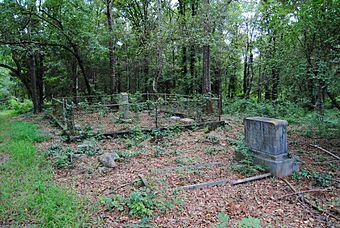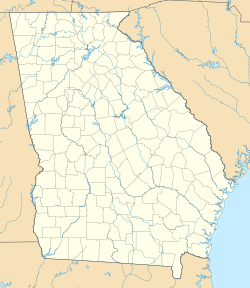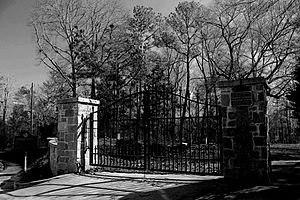Gospel Pilgrim Cemetery facts for kids
Quick facts for kids |
|
|
Gospel Pilgrim Cemetery
|
|

Morton Family Plot in the Gospel Pilgrim Cemetery
|
|
| Location | 530 Fourth Street Athens, Georgia |
|---|---|
| Area | 10.1 acres (4.1 ha) |
| Built | 1882 |
| Website | www.gospelpilgrimcemetery.com |
| NRHP reference No. | 06000285 |
| Added to NRHP | April 19, 2006 |
The Gospel Pilgrim Cemetery was started in 1882 in Athens, Georgia. It was a special burial ground for African American people. This cemetery covers about 10 acres and has an estimated 3,500 graves. Most of these graves do not have headstones.
The Gospel Pilgrim Society created the cemetery. This group was a social and helpful organization that offered burial insurance. In 2006, the cemetery was added to the National Register of Historic Places. This means it is an important historical site.
The University of Georgia's New Media Institute once set up a phone number for visitors. People could call this number to hear stories about the cemetery's history. They also heard comments from Rev. Archibald Killian, who knew a lot about black history in the area.
Contents
The Gospel Pilgrim Society: A Helping Hand
After the Civil War, many social and charitable groups became popular. These groups were like clubs that helped their members. By 1912, the African-American community in Athens, Georgia, had eight such groups. One of these was the Gospel Pilgrims.
These groups had about 2,500 members in 1912. This was about 75 percent of all adult black people in Athens. The name "Gospel Pilgrim" has a mysterious origin, and no one knows for sure where it came from.
History of the Cemetery Grounds
In 1882, the Gospel Pilgrim Society bought 8.25 acres of land. They purchased it from the family of William P. Talmadge, who was a white blacksmith. His wife, Elizabeth Talmadge, sold the land for $238.50. Green Bullock, a laborer, was the president of the society at that time.
Later, in 1902, the society bought another 0.75 acres. In 1905, a small piece of land was given to the nearby Springfield Baptist Church. This gave the cemetery its current size and shape. It now borders Fourth Street and the Seaboard Airline Railway. A survey in 2004 found the cemetery is actually a little over 10 acres.
The first burials happened in 1885. Many of these early graves belonged to the family of Monroe B. Morton. He was a very successful businessman in Athens. He owned property, published a newspaper, and built the Morton Building. This building included the Morton Theater and offices for African American professionals.
Gospel Pilgrim was the first large cemetery in Athens controlled by African Americans. Other smaller cemeteries were connected to churches. People were buried at Gospel Pilgrim regularly until the 1960s. The busiest time for burials was the 1940s. After that, the cemetery was not used as much and fell into disrepair. This was likely because there wasn't enough money to care for it. The very last burial took place in 2003.
In 2002, the cemetery was declared an "abandoned property." This means it had no clear owner. A lawyer found a Georgia law that allows local governments to care for abandoned properties. They can do this without actually owning the land.
Bringing the Cemetery Back to Life
In 2007, Athens-Clarke County decided to help restore the cemetery. They set aside $350,170 for the project. The restoration work was finished on October 13, 2008.
In 2009, the project received two awards. It got an Outstanding Achievement Award from the Athens-Clarke Heritage Foundation. It also received an Excellence in Rehabilitation Award from the Georgia Trust for Historic Preservation. These awards recognized the great effort to bring the cemetery back to its former state.
Important People Buried Here
Many important people are buried at Gospel Pilgrim Cemetery. Here are a few:
- Madison Davis: He was one of two black state lawmakers from Clarke County during a time called Reconstruction. He had been enslaved before. His grave has a clear headstone.
- Monroe Bowers "Pink" Morton: He was the successful businessman who built the famous Morton Theatre in Athens.
- Harriet Powers: She was a former enslaved person and a talented folk artist. She was known for her amazing quilts. Her grave was found again in 2005.




